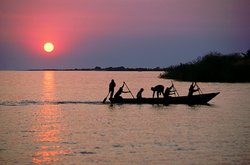Lake Tanganyika
|
|
Lake Tanganyika is a large lake in central Africa (3° 20' to 8° 48' South and from 29° 5' to 31° 15' East). It is estimated to be the second oldest (and second deepest) lake in the world after Lake Baikal in Siberia.
The lake is situated within the Western Rift of the Great Rift Valley and is confined by the mountainous walls of the valley. It is the largest rift lake in Africa and the second largest lake by surface area on the continent. It is the deepest lake in Africa and holds the greatest volume of fresh water. It extends for 673 km in a general north-south direction and averages 50 km in width. The lake covers 32,900 km², with a shoreline of 1,828km and a mean depth of 570 m and a maximum depth of 1,470 m (in the northern basin) it holds an estimated 18,900 km³. The enormous depth and tropical location of the lake prevent 'turnover' of watermasses, which means that much of the lower depths of the lake are so-called 'fossil water' and are anoxic (lacking oxygen). The catchment area of the lake covers 231,000 km², with two main rivers flowing into the lake, numerous smaller rivers and streams (due to the steep mountains that keep drainage areas small), and one major outflow, the Lukuga, which empties into the Congo River drainage. The major inflows are Ruzizi River, entering the north of the lake from Lake Kivu, and the Malagarasi River, which is Tanzania's second largest river entering in the east side of Lake Tanganyika. The Malagarasi pre-dates Lake Tanganyika and was formerly continuous with the Congo river.
The lake is divided between the four countries – Burundi, Democratic Republic of the Congo (DRC), Tanzania and Zambia, with the DRC (45%) and Tanzania (41%) possessing the majority of the lake.
The lake holds at least 300 species of cichlid fish and 150 non-cichlid species, most of which live in the benthic zone (near the bottom). The largest biomass of fish, however, is in the pelagic zone (open waters) and is dominated by six species - two species of "Tanganyika sardine" and four species of predatory Lates (related to, but not the same as, the Nile Perch that has devastated Lake Victoria cichlids). Almost all (98%) of the Tanganyikan cichlid species are endemic to the lake. This kind of elevated endemism is also found among numerous invertebrates in the lake, most especially the molluscs (which are notably convergent on marine morphologies), crabs, copepods, leeches, etc.
The lake's fishes serve as a major source of protein for local peoples. Currently there are around 45,000 people directly involved in the fisheries operating from almost 800 sites, there around 1 million people dependent on the fishers, and Lake Tanganyika fish can be found exported throughout East Africa. Commercial fishing began in the mid-1950s and has had an extremely heavy impact on the pelagic fish species, in 1995 the total catch was around 180,000 tonnes. Former industrial fisheries, which boomed in the 1980s, have subsequently collapsed.
The lake was first discovered by Europeans in 1858 when the explorers Richard Burton and John Speke reached it while exploring for the source of the Nile River. Speke continued and found the actual source, Lake Victoria.
See also
de:Tanganjikasee et:Tanganjika järv es:Lago Tanganica fr:Lac Tanganyika ja:タンガニーカ湖 nl:Tanganyikameer pl:Jezioro Tanganika ro:Lacul Tanganyika sl:Tanganjiško jezero fi:Tanganjikajärvi sv:Tanganyikasjön zh:坦干依喀湖

